Predictions and Survey Results on the Future of Generative AI
Generative AI tools and usage have reached high levels as of 2023. Although it has been less than a year since the launch of many of these tools, they have started to be used by many companies.
According to Google, rather than what artificial intelligence is, searches for how to do with artificial intelligence have started to increase. This situation is enough to show us how searches and needs have evolved:
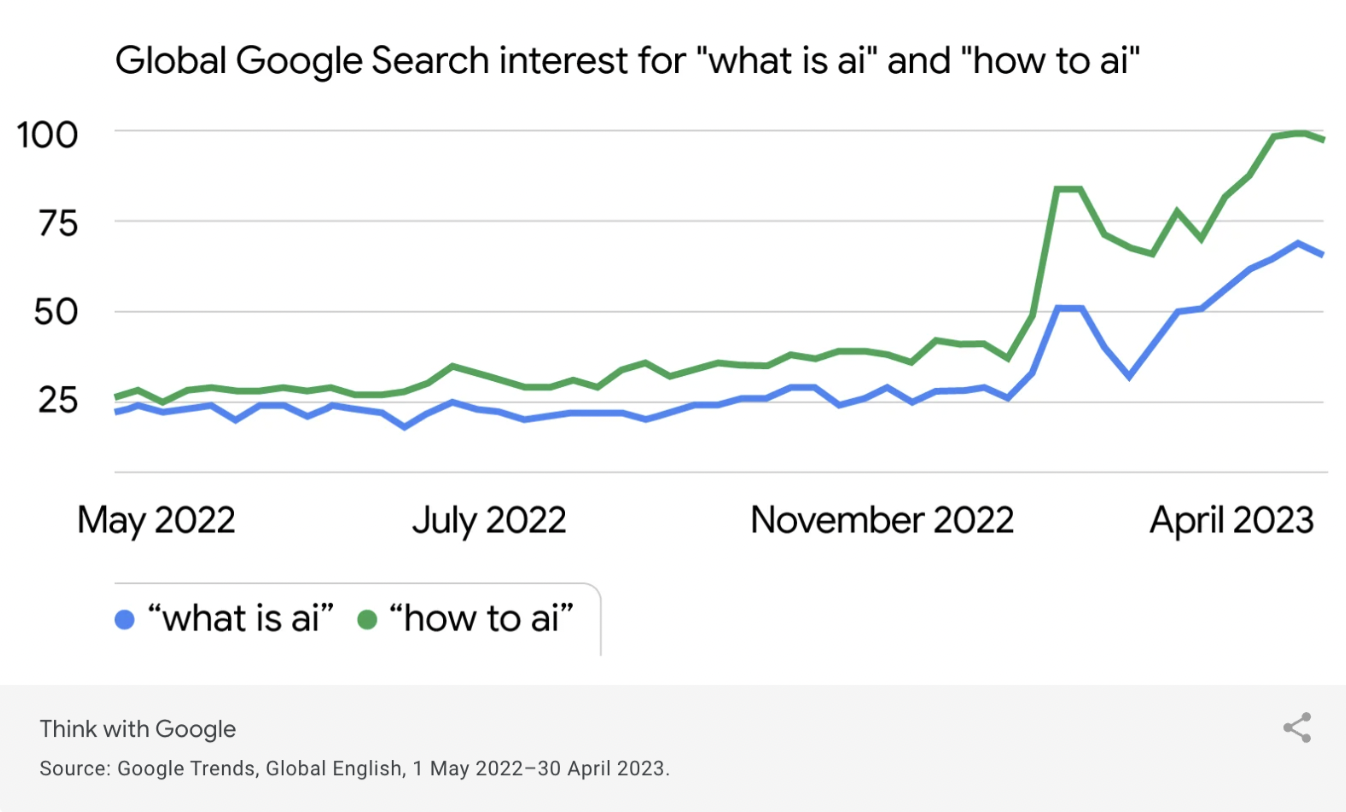
The global AI market is expected to reach $1.81 trillion by 2030. While the current AI market is already large, it will grow more than 13 times over the next 10 years:
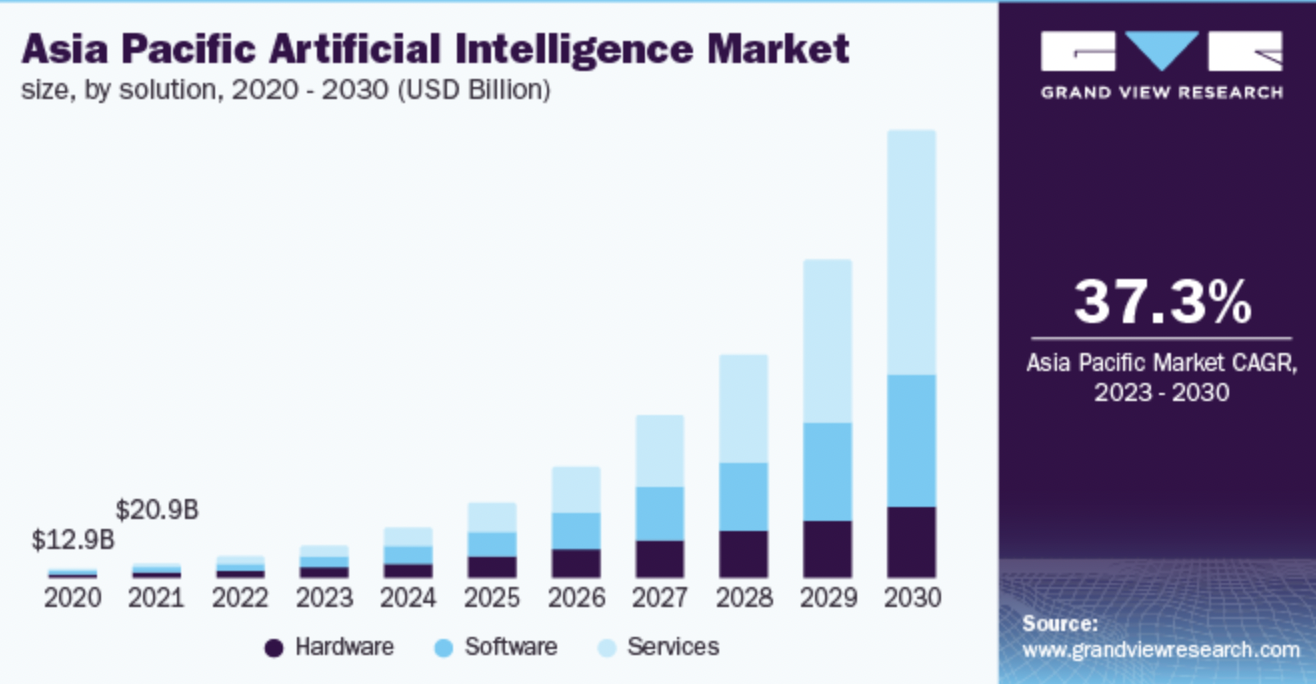
(source: https://www.grandviewresearch.com)
With recent developments, artificial intelligence has gone from being a topic of interest to technology employees to becoming a focal point and even one of the goals of company leaders. Managers at the CEO or CMO level allocate budget to use AI tools in every subject and constantly examine the use of different tools.
According to the survey conducted by mckinsey.com, approximately 25% of C-level executives say they use AI tools in their work. In the continuation of the survey, it is stated that AI developments are discussed in one quarter of the board meetings of the companies.
If we look at more survey results, 40% of the survey participants say that companies will increase their AI investments in general due to developments in Gen AI. My aim in this article is to reveal the results of the transition between AI and Generative AI with statistics. According to another survey result, 75% of CEOs believe that companies with advanced Generative AI will have a competitive advantage.
If you have difficulty convincing C-level executives, I can suggest the following:
- Explain the benefits of AI: For example, you could lead a presentation where you automate processes such as customer service or product development using AI.
- Demonstrate the applicability of AI: For example, you can automate customer service calls using AI and show the results statistically.
- Minimise risks: Show that you have also considered the potential risks of AI and how they can be dealt with. For example, showing how data security is taken into account when using AI.
- Alignment with company goals: Show how AI can help your company's long-term goals. For example, by using AI, you can expand into new markets and develop new products. This section should be slightly customised as the goals may vary for each company.
Companies using AI culture and the capabilities that can be made by AI were the first to discover the positive effects of Generative AI. Thanks to Gen AI tools, they were able to outperform other competitors in some areas. According to the survey results conducted by the same company, the use of Gen AI was seen to encourage the adoption of other artificial intelligence tools in companies.
Game producer companies are working to improve their new games with AI developments. Generative AI can significantly reduce the cost of creating 2D and 3D content for games and the speed at which things get done. You can find how many initiatives there are in this sector alone in the image below:
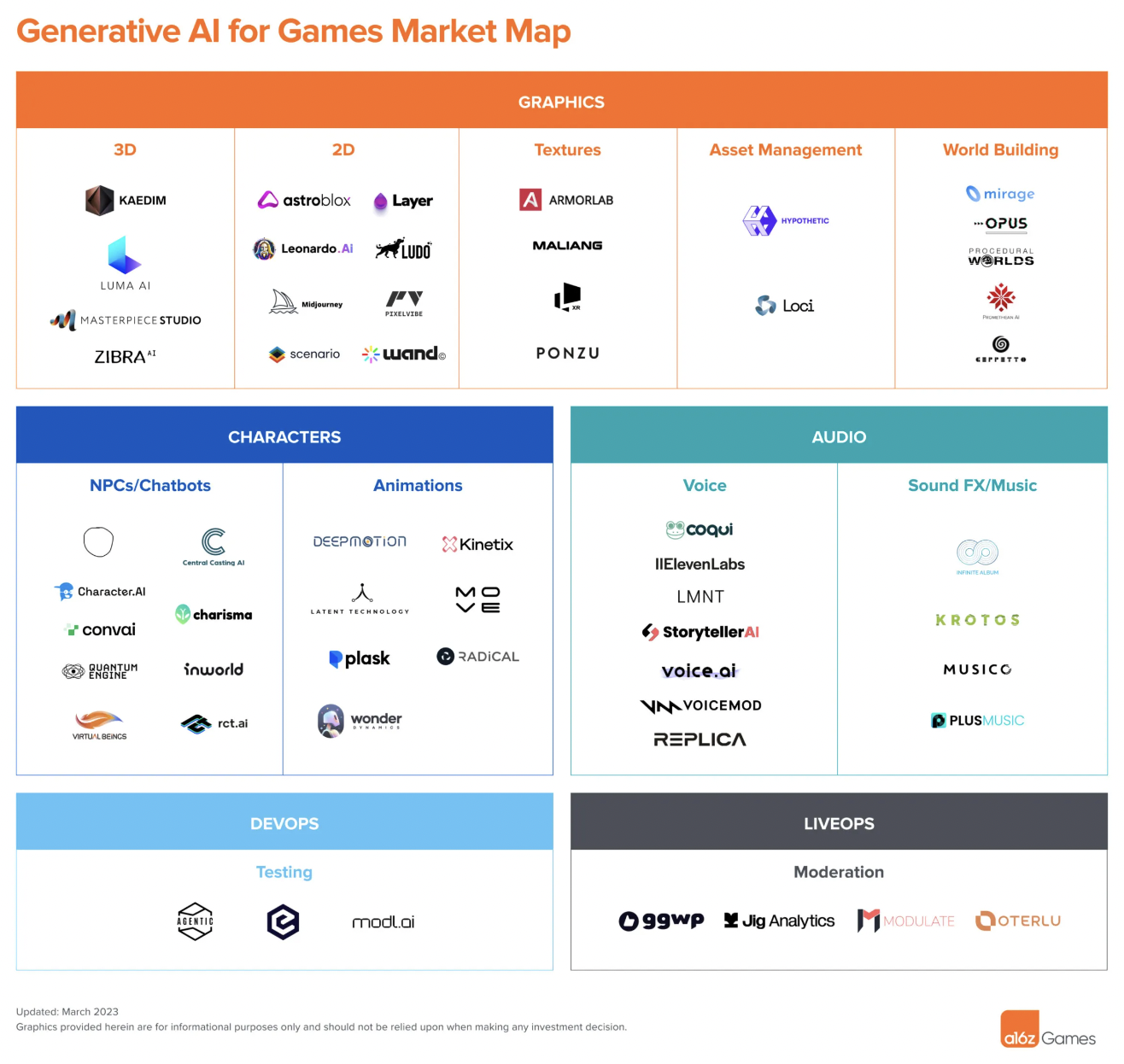
The percentage of organisations adopting any AI tool has remained stable since 2022, and usage continues to be concentrated in a small number of business lines. Many organisations in Turkey are also trying to make a breakthrough in this area.
1. It's Early, But Generative AI Use Is Already Widespread
Findings from the survey, conducted in April 2023, show that although Generative AI is new, experimentation with the tools is relatively widespread and respondents expect new AI capabilities to transform their industries.
According to the survey, Gen AI is gaining traction across the business world. It is seen to be used not only in the main line of business but also outside of business. 22% of all respondents say they regularly use AI in their own business.
The survey results by industry are as follows. Naturally, technology companies use AI the most:
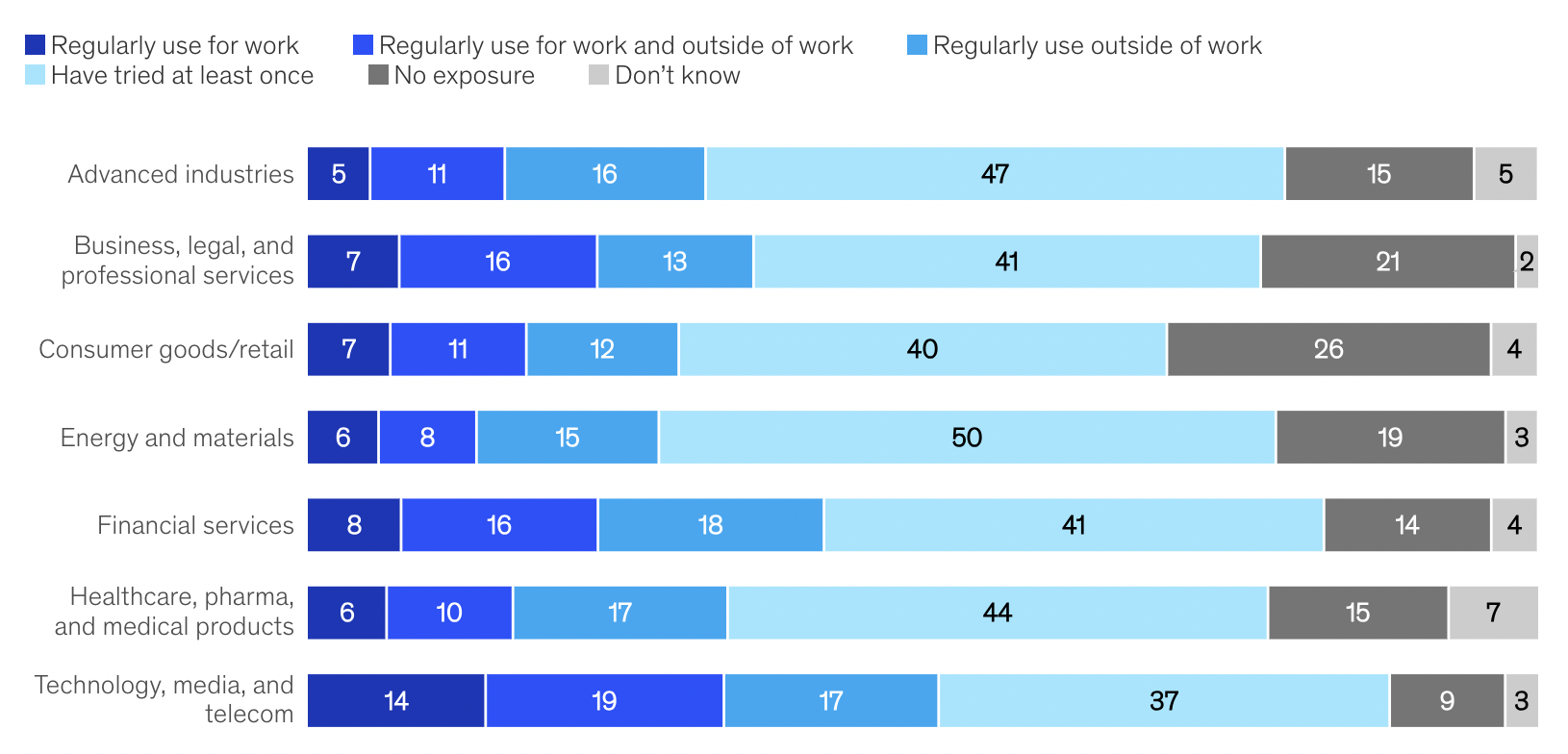
While people in the senior manager position appear to be ahead in the job title survey, C-level managers come in 2nd place:
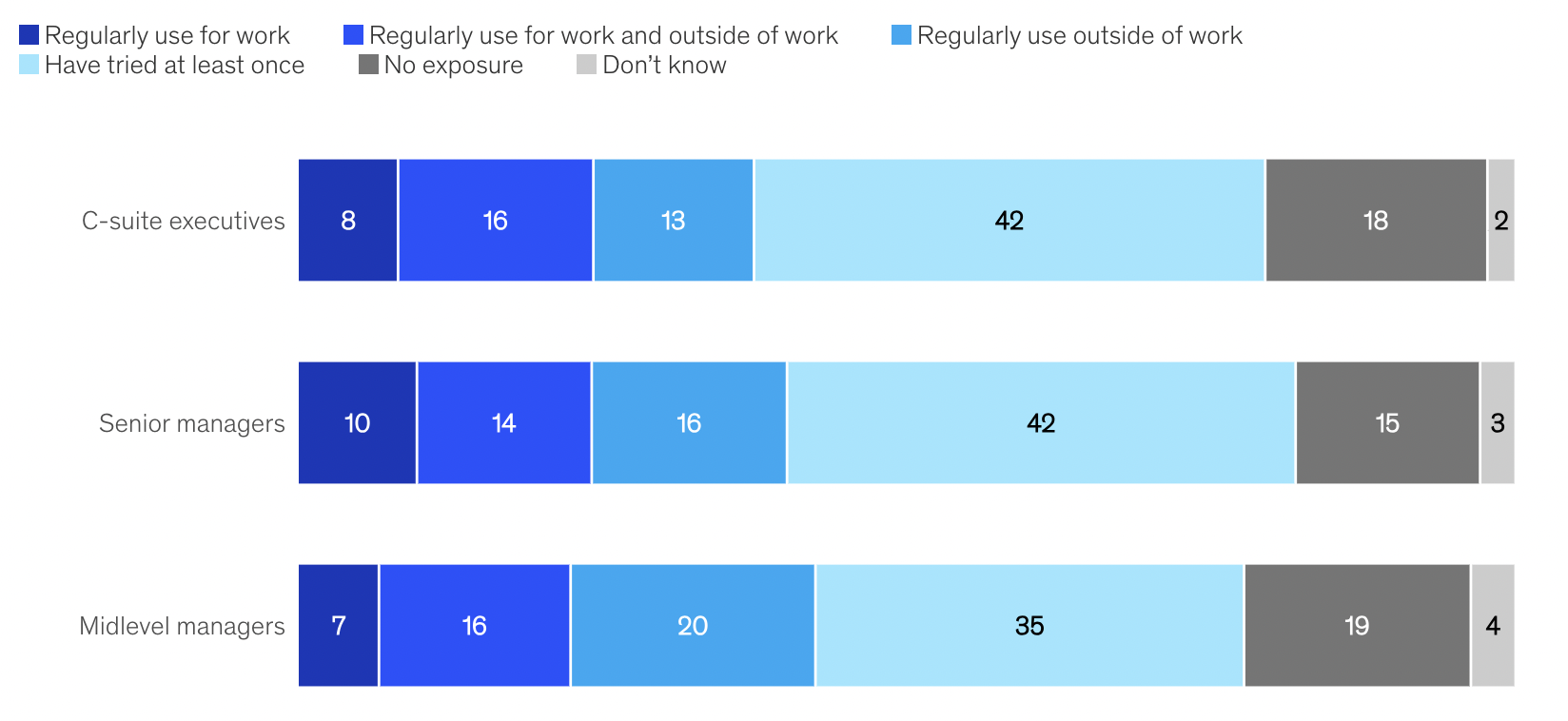
One-third of all respondents say their organisation regularly uses generative AI in at least one line of business. This statistic tells us that 60% of organisations reporting AI adoption are using Gen AI. Of those who state that AI is adopted in their companies, 40% state that their companies expect to invest more in artificial intelligence in general thanks to Gen AI. 28% say that the use of Gen AI is on the meeting agendas of their boards of directors.
Expectations for Gen AI impact in 2023 are high. Three-quarters of survey respondents expect Gen AI to cause a significant or disruptive change in competition in their industry in the next 3 years. Survey respondents working in the technology and financial services sectors are the most likely to expect disruptive change from Gen AI.
While previous research suggests that all sectors are likely to see some degree of impact, the level of impact will vary by sector. Unsurprisingly, technology companies are likely to see the highest impact at a rate of 9%. When we take a look at other sectors, knowledge-based industries such as banking and finance (5%), pharmaceuticals and medical products (5%) and education (4%) may be adversely affected by these developments, while manufacturing-based sectors such as aviation, automotive and electronics, which have a less disruptive impact, seem to be at the forefront. The main reason for this can be explained as the fact that AI does not fulfil physical activities. For example, it will be more difficult for companies that manufacture or repair an automobile part to be negatively affected by these developments.
UK energy provider Octopus Energy said that 44 per cent of customer service-related emails to the company are now answered by AI.
Many Companies Do Not Address the Potential Risks of Generative AI
mckinsey.com survey responses show that many companies have yet to address the potential risks from generative AI. According to the survey, few organisations appear to be fully prepared for the widespread use of Gen AI or the risks that these tools can bring.
Only 21% of respondents who report AI adoption say their organisation has established policies that regulate employees' use of AI technologies in their work. When asked about AI risks, few respondents say their organisations have mitigated the risk of "inaccuracy", the most frequently cited risk associated with AI. Issues such as cybersecurity or intellectual property take a back seat. In addition, 32 per cent of companies say they are working to correct misinformation:
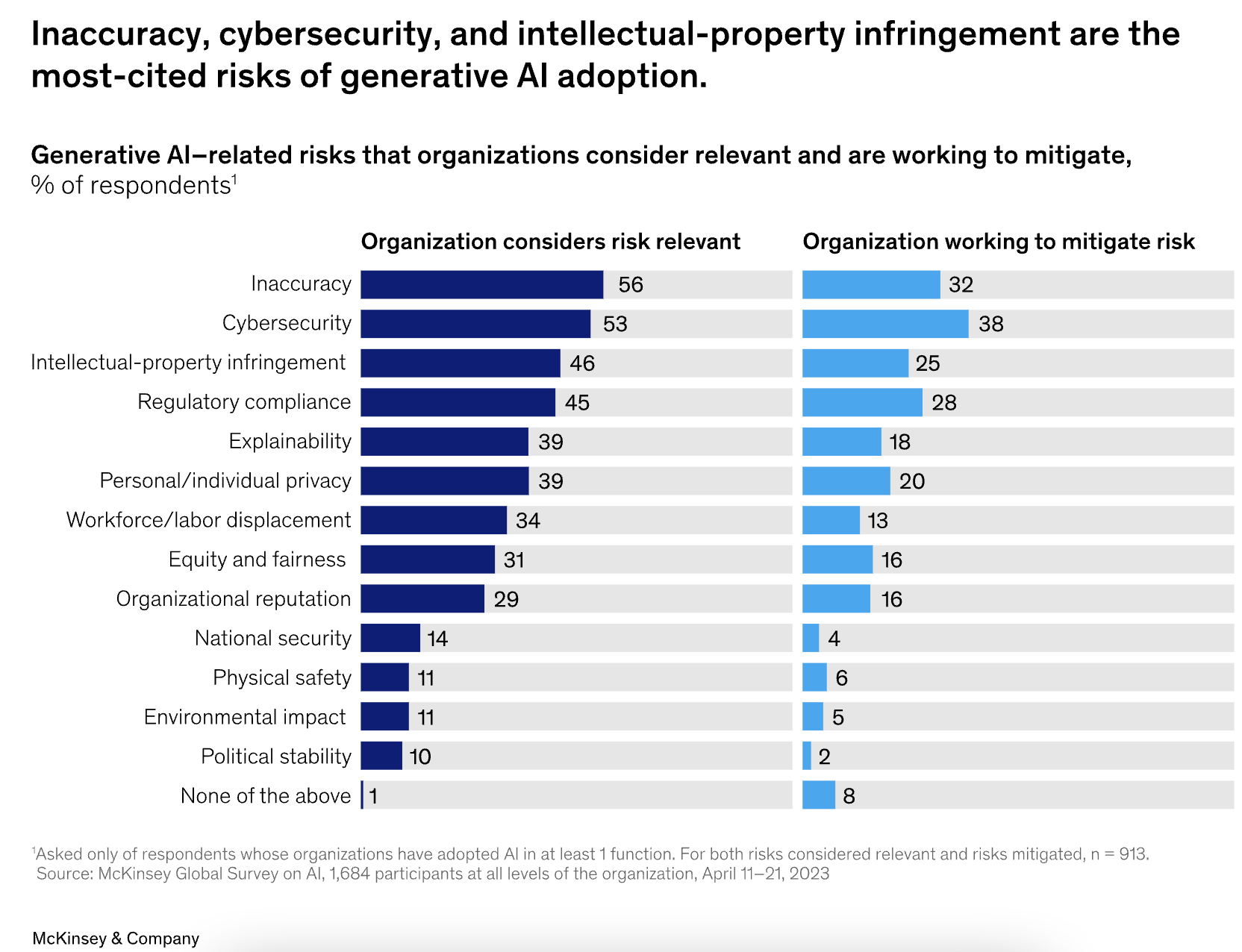
2. Industry Leading Companies Ahead with the Help of Generative AI
Companies that are realising significant value from AI are using AI in more lines of business than other companies, particularly in product development and risk and supply chain management.
Looking across all AI capabilities, including more traditional machine learning capabilities, robotic processes, and products such as chatbots, companies that are high performers in AI are at the forefront of improving products, adding new features to existing products, and creating new AI-based products.
The companies concerned are using AI or seeking AI consultancy not only for product development but also for further optimising their internal structures, for example in HR, performance management and workforce distribution optimisation. You can see the responses such as cost reduction, creation of new revenue items and revenue increase more clearly in the graph below:
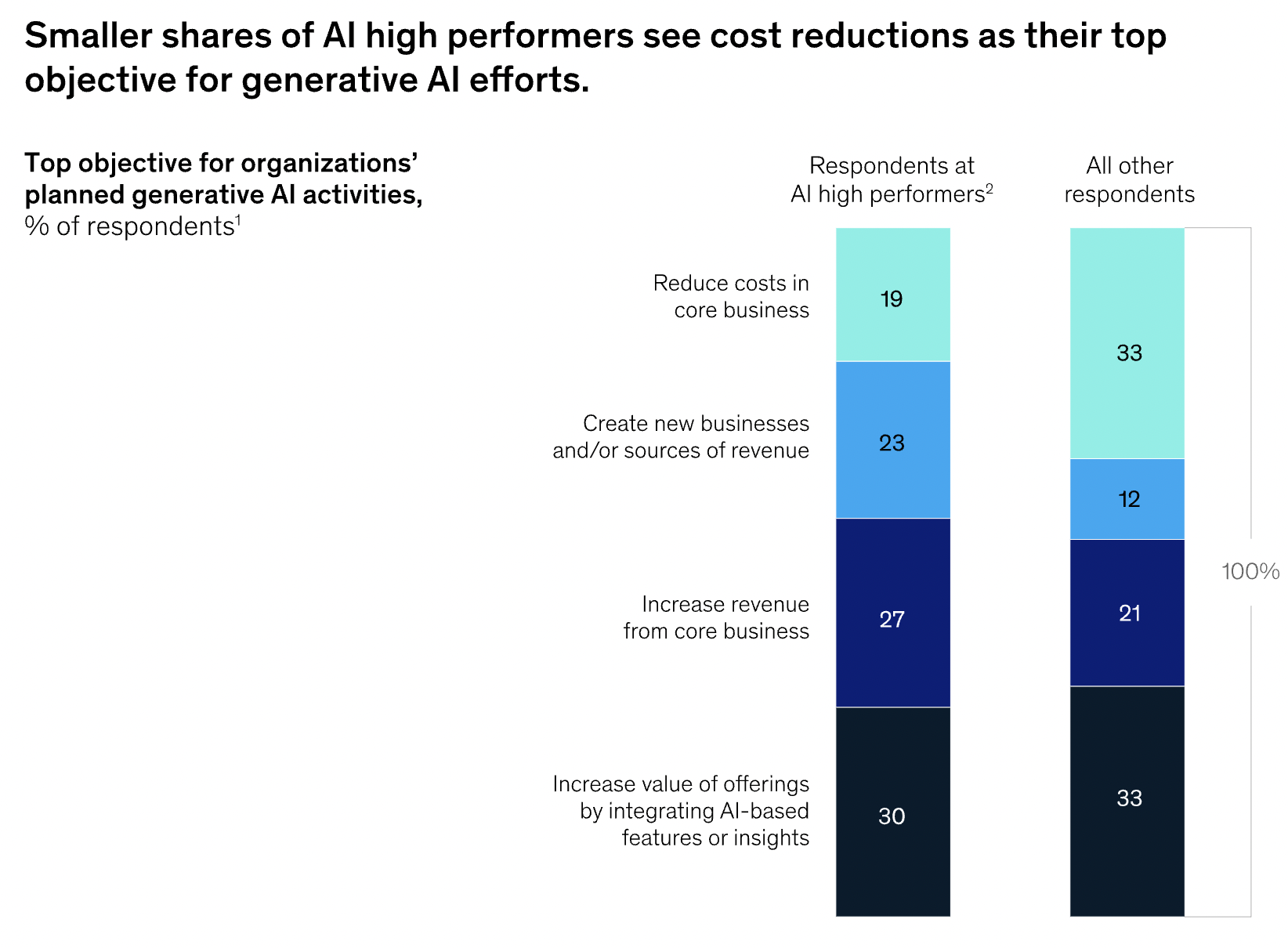
Companies that are closely interested in AI and perform well in this field spend more than 20 per cent of their digital marketing budgets on AI tools or studies. They are also using AI capabilities (such as prompt engineering) more across the organisation.
Survey respondents who are high performers in AI cite models and tools such as monitoring model performance and retraining models as needed over time as their biggest challenge. Other respondents cite strategy challenges, such as setting an AI vision that is relevant to their business or finding sufficient resources:
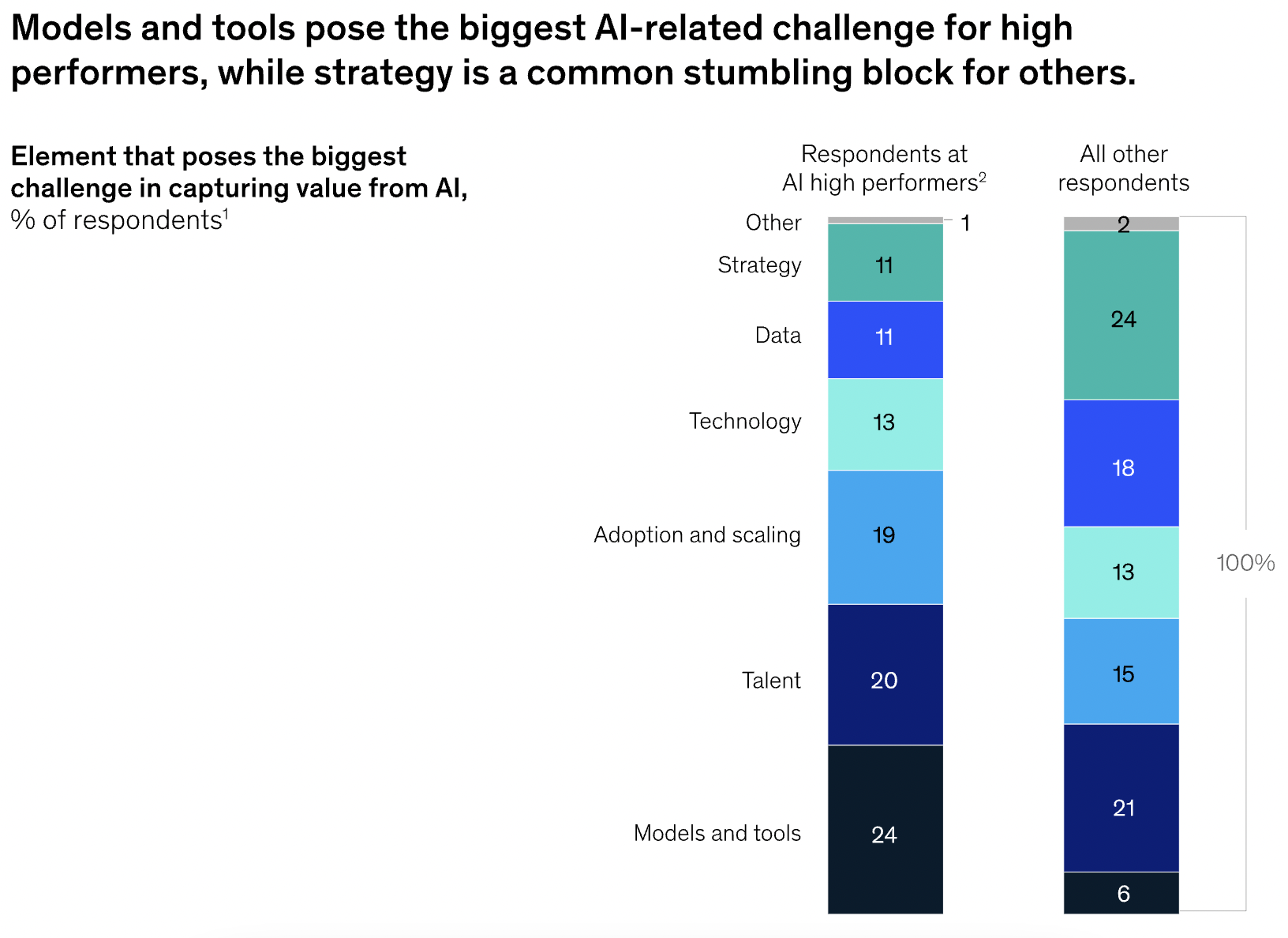
We see further evidence from the survey results that companies trying to invest in this area are not even mastering AI adoption best practices, such as MLOps approaches. A quarter of respondents say that all AI systems are monitored and equipped with instant alerts, compared to just 12 per cent of other respondents. These automations also show us how far processes are being optimised in the early stages.
3. The Impact of AI on the Labour Force is Expected to be Significant
According to last year's data, companies using AI hired the most data engineers, machine learning engineers and AI data scientists. With the adoption of artificial intelligence, the need for these skill sets will increase. If you want to stand out in these areas or if you don't have a career goal yet, you can turn to these areas.
According to the survey results below, you can see the comparison of hiring for related roles for companies by 2022. Especially roles such as machine learning engineer continued to be difficult to recruit in 2023:
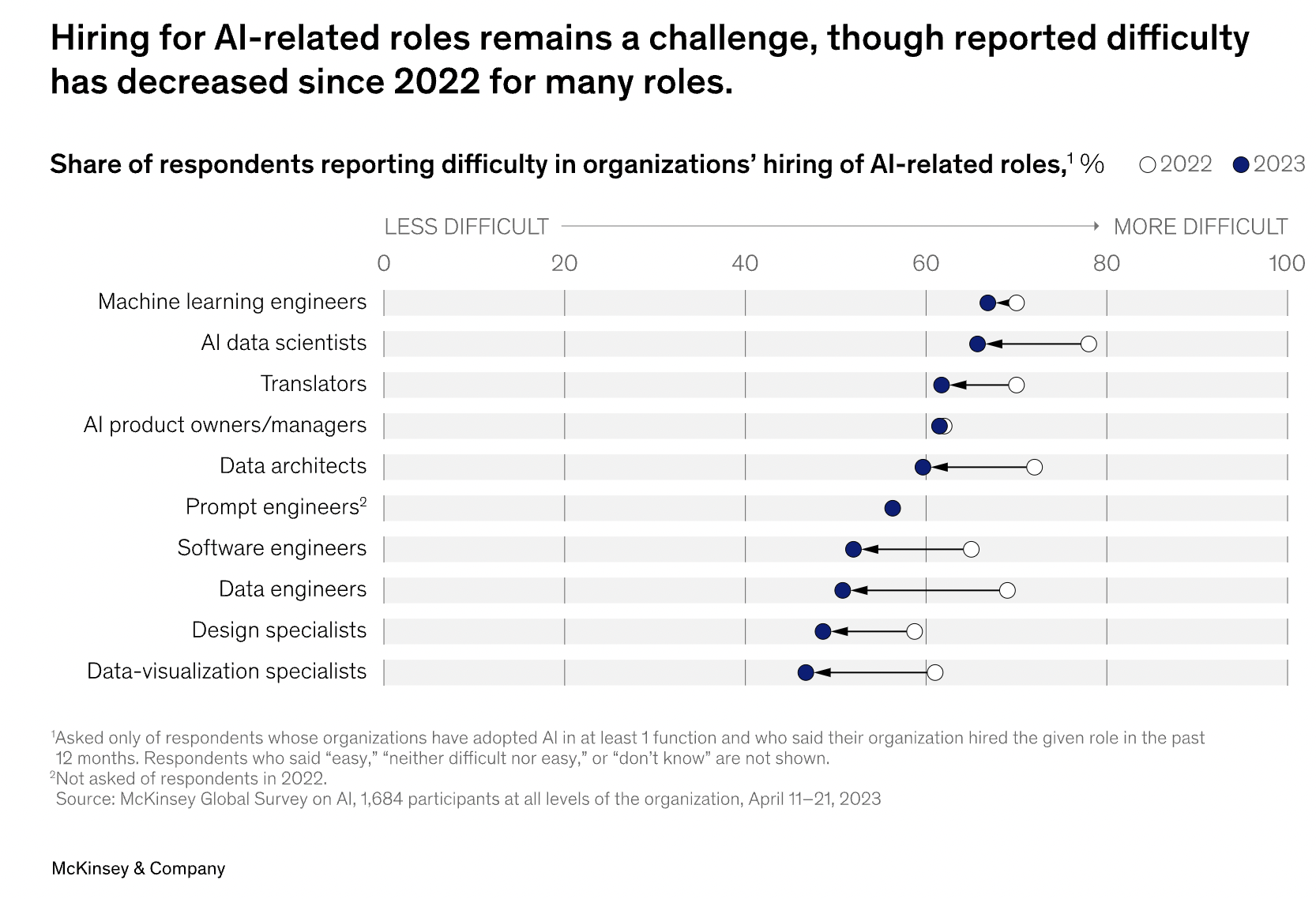
Looking ahead to the next 3 years, respondents predict that the adoption of AI will reshape many roles in the workforce and the number of employees:
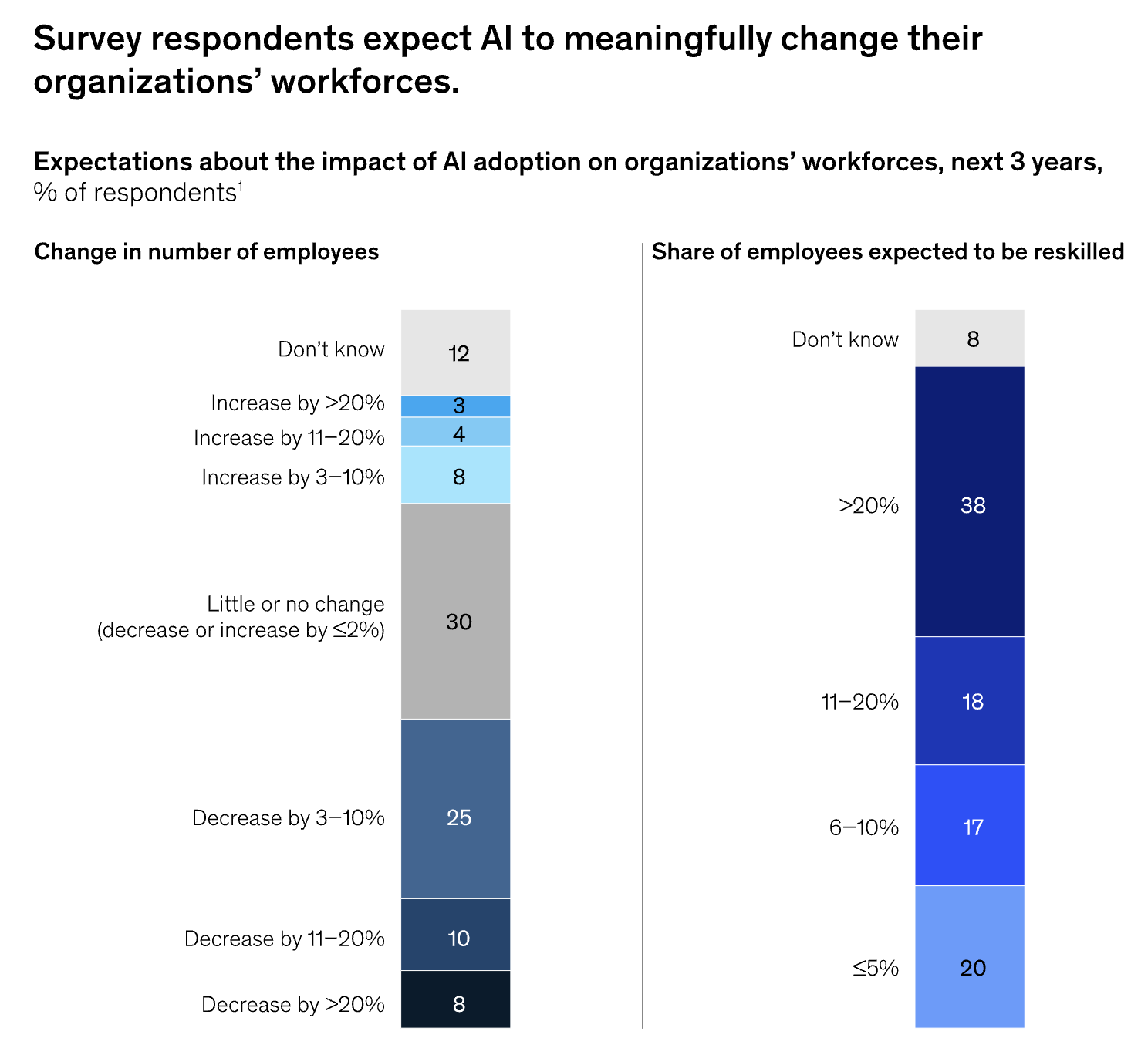
When we analyse the departments, a 54% reduction in service operations and a 45% reduction in supply chain management may occur in the next 3 years:
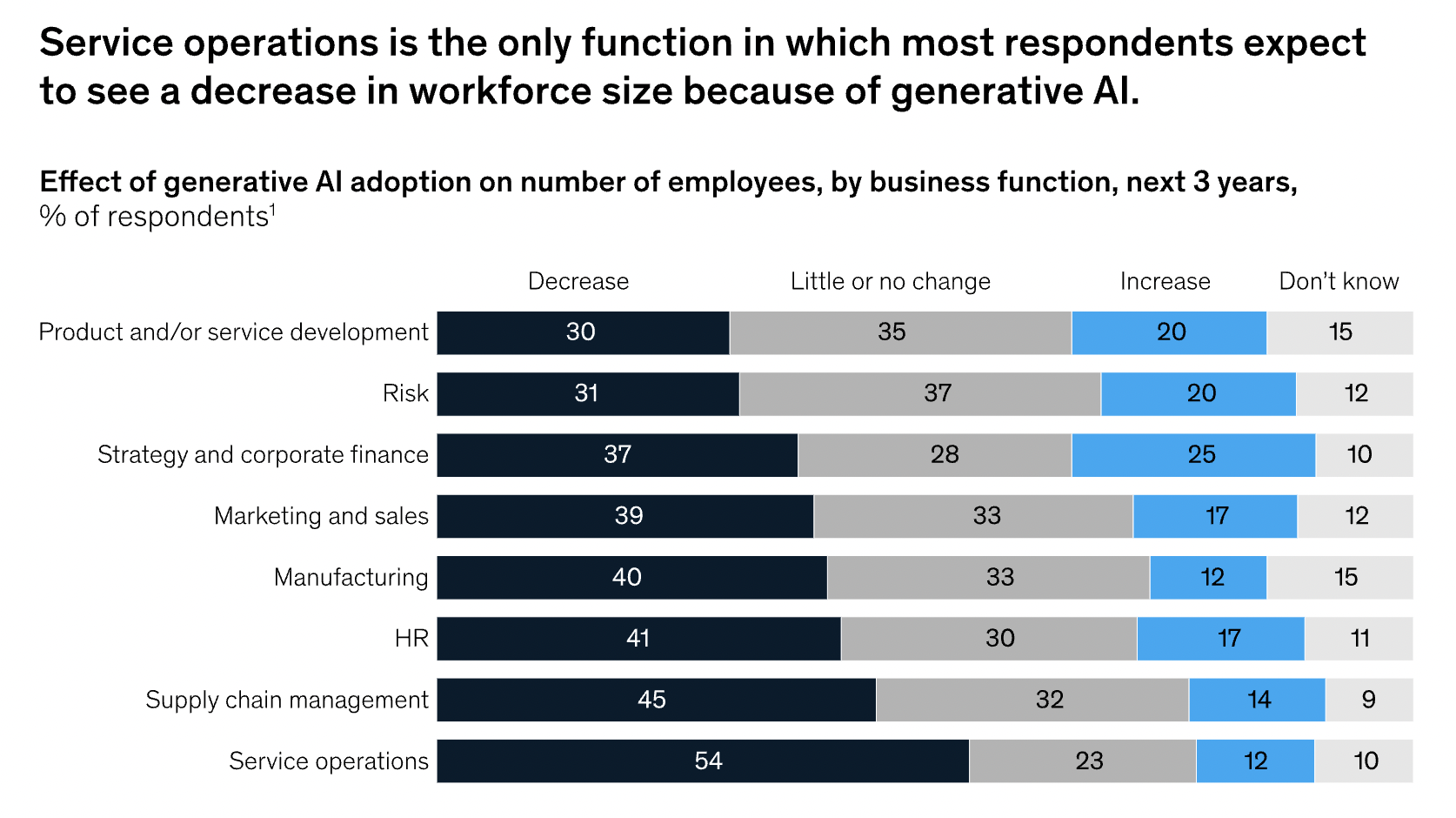
As you have seen towards the end, the data shows how important Gen AI is in the future. While many business branches are shrinking, it seems that "AI" or even "Generative AI" will be used more in some job descriptions. In the light of this data in the next 3 years, prepare yourself for the future by optimising all your processes with AI.
If your teams have not yet been trained on this subject, they can at least write prompts at a basic level and plan to save time from the work they do in their own departments in these processes. Everything is changing very fast and keeping up with it is very important for the future of your companies.


















